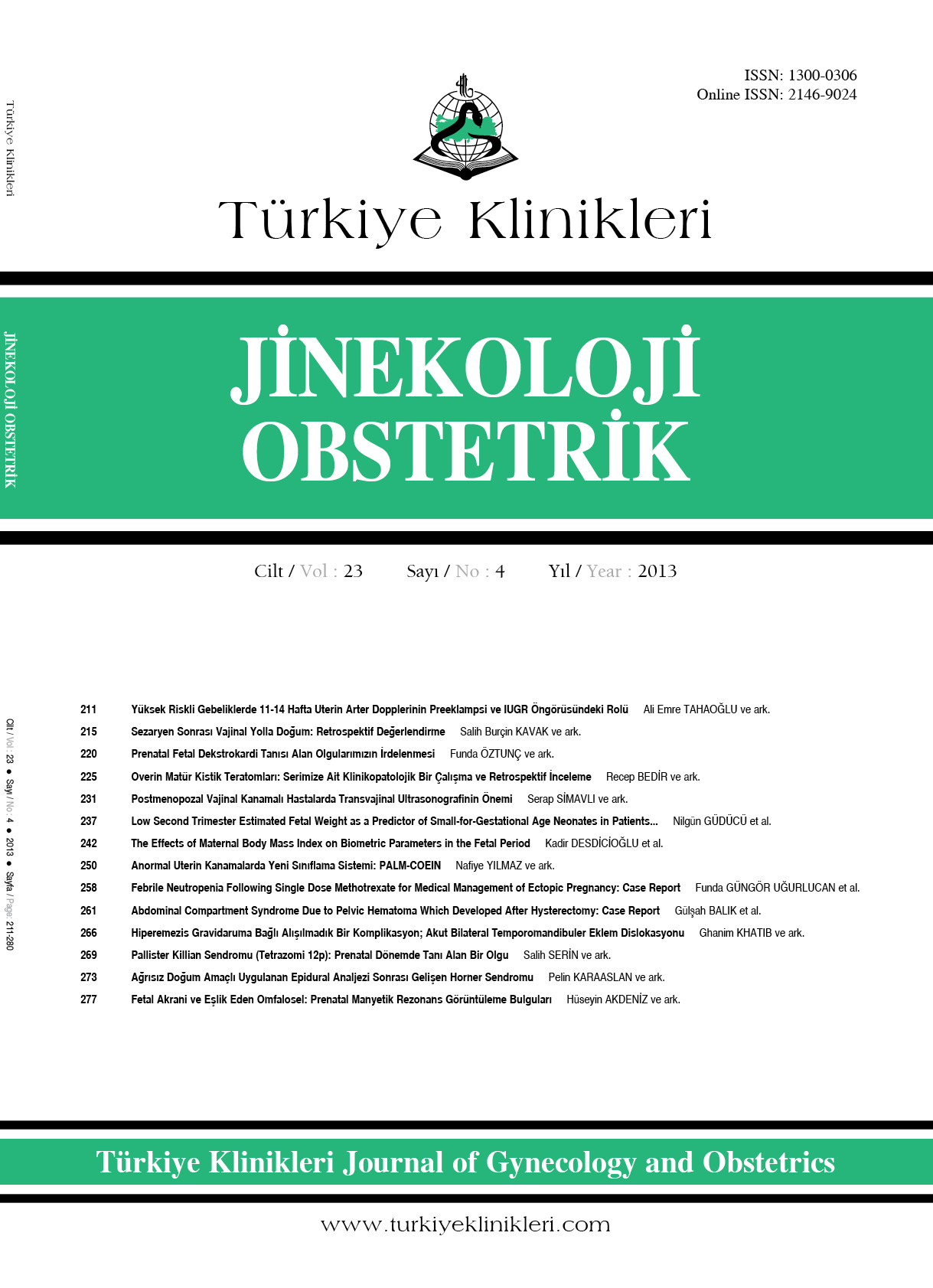Open Access
Peer Reviewed
CASE REPORTS
3568 Viewed1469 Downloaded
Acute Bilateral Temporomandibular Joint Dislocation; an Unusual Complication of Hyperemesis Gravidarum: Case Report
Hiperemezis Gravidaruma Bağlı Alışılmadık Bir Komplikasyon; Akut Bilateral Temporomandibuler Eklem Dislokasyonu
Turkiye Klinikleri J Gynecol Obst. 2013;23(4):266-8
Article Language: TR
Copyright Ⓒ 2025 by Türkiye Klinikleri. This is an open access article under the CC BY-NC-ND license (http://creativecommons.org/licenses/by-nc-nd/4.0/)
ÖZET
Hiperemezis gravidarum, gebelikteki bulantı-kusmanın en şiddetli formudur. Hastalarda, %5'i aşan kilo kaybı, elektrolit dengesizliği, asetonüri ve oligüri görülebilmektedir. Bugüne kadar tarif edilen nadir komplikasyonlar arasında Wernicke ensefalopatisi, göz küresinin subluksasyonu, özofagus yırtıkları ve pnömotoraks bulunmaktadır. Temporomandibüler eklem patolojilerinin sıklığı gebelikte değişmese de, bu makalede sunulan olguda hiperemesis gravidaruma bağlı olarak temporomandibuler dislokasyon gelişmiştir. temporomandibüler başın glenoid fossanın dışına çıkması olarak bilinen hastalık, esas olarak eklemi hiperekstansiyona zorlayan hareketler esnasında meydana gelmektedir. Bildiğimiz kadarıyla, bu açıdan olgumuzda bir ilk tarif edilmiştir.
Hiperemezis gravidarum, gebelikteki bulantı-kusmanın en şiddetli formudur. Hastalarda, %5'i aşan kilo kaybı, elektrolit dengesizliği, asetonüri ve oligüri görülebilmektedir. Bugüne kadar tarif edilen nadir komplikasyonlar arasında Wernicke ensefalopatisi, göz küresinin subluksasyonu, özofagus yırtıkları ve pnömotoraks bulunmaktadır. Temporomandibüler eklem patolojilerinin sıklığı gebelikte değişmese de, bu makalede sunulan olguda hiperemesis gravidaruma bağlı olarak temporomandibuler dislokasyon gelişmiştir. temporomandibüler başın glenoid fossanın dışına çıkması olarak bilinen hastalık, esas olarak eklemi hiperekstansiyona zorlayan hareketler esnasında meydana gelmektedir. Bildiğimiz kadarıyla, bu açıdan olgumuzda bir ilk tarif edilmiştir.
ABSTRACT
Hyperemesis gravidarum, is the most severe form of pregnancy induced nausea-vomiting. More than 5% weight loss, electrolyte imbalance, acetonuria and oliguria can be seen in the patients. Up to date, infrequent complications like Wernicke encephalopathy, eyeball subluxation, esophageal ruptures and pneumothorax have been reported. Although the frequency of the temporomandibular joint disorders does not change during pregnancy, in the presented case, a temporomandibular dislocation has been developed due to hyperemesis gravidarum. The disorder, known as displacement of the mandibular condyle outside the glenoid fossa, mainly occurs during movements which force the joint for hyperextension. To the best of our knowledge, regarding to this condition, a first has been described in our case.
Hyperemesis gravidarum, is the most severe form of pregnancy induced nausea-vomiting. More than 5% weight loss, electrolyte imbalance, acetonuria and oliguria can be seen in the patients. Up to date, infrequent complications like Wernicke encephalopathy, eyeball subluxation, esophageal ruptures and pneumothorax have been reported. Although the frequency of the temporomandibular joint disorders does not change during pregnancy, in the presented case, a temporomandibular dislocation has been developed due to hyperemesis gravidarum. The disorder, known as displacement of the mandibular condyle outside the glenoid fossa, mainly occurs during movements which force the joint for hyperextension. To the best of our knowledge, regarding to this condition, a first has been described in our case.
MENU
POPULAR ARTICLES
MOST DOWNLOADED ARTICLES





This journal is licensed under a Creative Commons Attribution-NonCommercial-NoDerivatives 4.0 International License.










